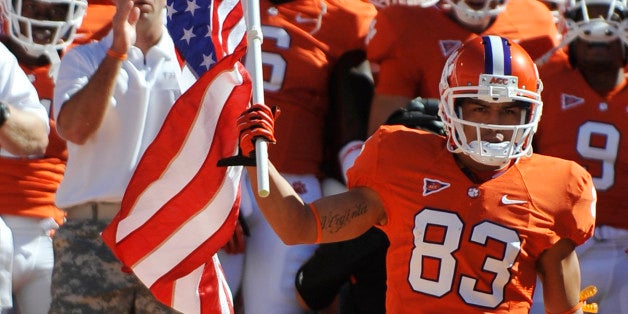
Science’s latest inconvenient truth is that 110 of 111 brains of football players studied showed signs of the debilitating brain damage Chronic Traumatic Encephalopathy (CTE), a degenerative disease that is caused by repeated blows to the head. With potentially trillions of dollars in damages payable, not just by the NFL, but the NCAA schools, and even high schools, it may be that insurance companies, along with moms, will be blowing the end-of-game whistle on one of the most popular entertainment forms in the world.
Just about two years ago, I took the CTE controversy and did the math for a piece called “The Death of American Football, Hockey and Rugby is Spelled M-O-M.” Yesterday’s news actually could make the projections of the costs of doing business even more astronomical.
Based on the NFL’s settlement with some of its players back in 2015, here is what we know is possible, using even the most conservative figures:
- NFL: The AP reported that, “The NFL expects 6,000 of nearly 20,000 retired players to suffer from Alzheimer’s disease or moderate dementia someday.” That estimate was based on data that we know now was very conservative and off. So if we assume that CTE damage is something for which, conservatively, 60% out of the 99% of impacted players will need compensation using the low number of $190,000 which the NFL offered as a settlement with some players in 2015, that’s potentially $2.28B, more or less in NFL compensation, ongoing, which could amount to billions more as players, damaged, retire.
- NCAA: 65 years of former college football players. About 1.1 million men who’ve played the game. If just 20% develop CTE-related dementia, that’s a 220,000 potential class action suit. If these players received just the $190,000 per player that the NFL players received, that was $41.8 billion in compensation. Up the number, based on the study to just 40% of players impacted, and that is $83.6B dollars.
- High Schools: 1,088,158 young men play high school football annually. If the number of players who develop CTE over their lifetimes is just 20 percent, high schools could pay out a whopping $2.48 trillion in compensation to those impacted over the last 60 years.
With three trillion dollars of damages, how does the ledger sheet balance? American Football, in all its levels, is a huge revenue-generating sport. Rugby and Australian Rules are globally huge sports entertainment businesses as well. Hockey, which can make changes to its play, also has exposure, as does Futbol/Soccer without rules to minimize impact. My estimates are just for American football, based on the available data, and are not scientific, just a penciling on the back of a napkin. Even if the leagues and college systems were able to use political pull to cap damages, the numbers are catastrophic for the continuation of sports where we know what the damage is going to be, and the players are paid such high salaries, which generally are all insured.
Add in all of the other high contact sports, and, for the ones who can’t change their rules to lessen impacts, the potential financial losses of continued play, globally, are a financial burden for what is, at the end of the day, an entertainment.
The science is clear, and, even if the NFL, NCAA, and the legislative bodies of America and the world can live in a state of denial, insurance companies, which deal in actuarial tables and risk assessment, will not.
The revenue that football and other high contact sports bring in globally is not enough to mitigate risk. It would be impossible for insurance companies to find reinsurance companies, the insurer’s insurer for big losses, that would backstop that kind of risk.
Contact sports will just cost too much to operate. The insurance bills alone would be staggering.
Then there are moms and dads. There are a bunch of contact sport rabid parents out there who love the game and will not believe that it’s possible that players are being harmed that badly.
Moms: They are being harmed that badly. If you put your child into a high contact sport, it’s not just about the hits. It’s about high speed falls and tackles thousands of time at lower impacts. The human brain is like an egg floating in your skull. There is no helmet that keeps it from smashing into your skull when it gets knocked around.
Forty-two varsity high school football players were studied in 2009. They sustained 32,510 impacts over a season, according to that study of of head impact exposure, appearing in the American Journal of Sports Medicine. That’s like being involved in approximately 774 car wrecks or more.
Per player.
Per year.
CTE chokes off the brain. It slowly robs the human who played a contact sport of their mental faculties in ways that deal with emotional control, critical thinking skills, and cognitive function.
It may explain why millions of people who have played high impact sports have moments of violent outbursts, suffer from chronic depression, rage, suicidal thoughts, and more.
So parents and young athletes are also facing very critical decisions. Is it worth the risk of so much lifetime damage, of a shortened life, to play a sport that pays money that turns poor and middle income families into the upper 5% overnight?
That decision may be one that they never get to make.
Unless pro sports and science can fix the free-floating brain inside a skull, the ledger sheet won’t add up in dollars for insurers, risks for players and families, or in fans’ growing knowledge that they are watching players actually kill themselves on the field in front of them.
Would you cheer at a car wreck?
You do every weekend that you go to a stadium, or turn on the television to catch a game that involves high contact sport.
